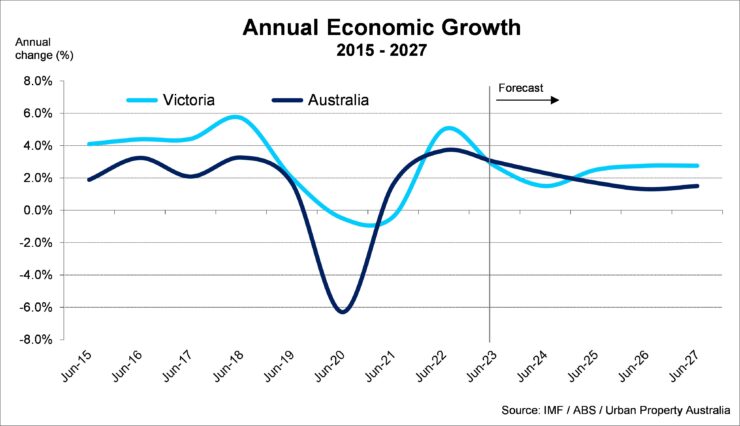Q3 2023 – Victorian Economic Overview
November 13th 2023 | , Urban Property Australia
Victoria’s economy is forecast to grow by 1.5% in the 12 months to June 2024, this follows an expected increase of 2.75% 2022/23 and is now estimated to be 8% larger than it was as at June 2019. The recent announcement of the Victorian Government’s decision to cancel its commitment to host the 2026 Commonwealth Games along with it considering using a public-private partnership to cover the cost of building the Suburban Rail Loop East however indicates that the state Government is increasingly struggling to manage its growing debt costs.

Victoria’s labour market conditions have been strong over the past year with demand for labour very strong and the supply of labour increased following the reopening of national borders. Employment has grown by 3.8% over the year to September 2023, following growth of 5% last year. The share of working-age Victorians in employment has risen to around record high levels, and the unemployment rate has fallen to 3.5%. Employment growth has been led by full-time positions, with full-time jobs comprising around 54% of the almost 340 000 jobs created since September 2020.
With employment already at a high level relative to the size of the workforce, and with economic growth moderating, employment growth is forecast to slow to 0.75% over the year to June 2024. Although the unemployment rate is forecast to rise to 4.25% by mid-2024, this will still be very low by historical standards.
Household consumption is forecast to make a smaller contribution to Victoria’s economic growth over the next 12 months, following two years of strong growth as spending recovered from an extended period of pandemic-related disruptions. High inflation, higher interest rates and increased consumer caution are expected to weigh on demand however, low unemployment, solid wages growth and substantial levels of savings should continue to support consumption.
Dwelling investment in Victoria, which reached its second-highest level on record last year, is forecast to decline modestly over the next 12 months. Higher interest rates and lower prices for existing dwellings have dampened demand for new housing, as is evident in a recent decline in building approvals.
However, there remains a large pipeline of residential construction work to be completed following a surge in building approvals during 2020/21, which were supported by then record-low interest rates and government incentives. This pipeline will support construction activity, aided by a gradual easing of supply constraints. From mid-2025, dwelling investment is forecast to return to growth.
Business investment is forecast to grow solidly next year, building on strong growth recorded over the past 12 months. Despite declining business confidence, the outlook for business investment is supported by a large pipeline of both non-residential and engineering construction projects. In the near term, higher input costs and ongoing material and labour shortages may continue to constrain construction activity.
Public demand is forecast to make a modest positive contribution to Victoria’s economic growth next year as temporary pandemic-related spending is wound down. A strong pipeline of government infrastructure and social housing projects will continue to underpin high levels of public investment. While final estimates of the cost of the Victorian Government’s decision to cancel its commitment to host the 2026 Commonwealth Games is yet to be announced, compensation for the decision is estimated to cost hundreds of millions with the Government understood to still complete $2 billion of associated Games-related projects throughout the regions of Victoria.
Victoria’s population growth was strong in the decade leading up to the pandemic, however, the closure of national borders following the onset of the pandemic had a significant negative impact on population growth, with Victoria’s population falling over 2020/21. Following the reopening of Australia’s borders, population growth began to recover strongly with further strong growth expected in the medium term. Victoria’s population growth is forecast to be above its long-term trend rate over the next three years.
Copyright © 2023 by Urban Property Australia All rights reserved. No part of this publication may be reproduced in any form, by microfilm, xerography, electronically or otherwise, or incorporated into any information retrieval system, without the written permission of the copyright owner.



